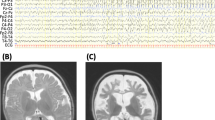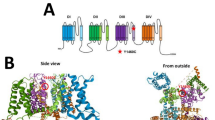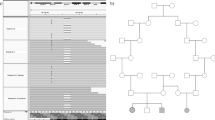Abstract
Febrile seizures affect approximately 3% of all children under six years of age and are by far the most common seizure disorder1. A small proportion of children with febrile seizures later develop ongoing epilepsy with afebrile seizures2. Segregation analysis suggests the majority of cases have complex inheritance3 but rare families show apparent autosomal dominant inheritance. Two putative loci have been mapped (FEB1 and FEB2), but specific genes have not yet been identified4,5. We recently described a clinical subset, termed generalized epilepsy with febrile seizures plus (GEFS+), in which many family members have seizures with fever that may persist beyond six years of age or be associated with afebrile generalized seizures6. We now report linkage, in another large GEFS+ family, to chromosome region 19q13.1 and identification of a mutation in the voltage-gated sodium (Na+)-channel ß1 subunit gene (SCN1B). The mutation changes a conserved cysteine residue disrupting a putative disulfide bridge which normally maintains an extracellular immunoglobulin-like fold. Co-expression of the mutant ß1 subunit with a brain Na+-channel ß subunit in Xenopus laevis oocytes demonstrates that the mutation interferes with the ability of the subunit to modulate channel-gating kinetics consistent with a loss-of-function allele. This observation develops the theme that idiopathic epilepsies are a family of channelopathies and raises the possibility of involvement of other Na+-channel subunit genes in febrile seizures and generalized epilepsies with complex inheritance patterns.
This is a preview of subscription content, access via your institution
Access options
Subscribe to this journal
Receive 12 print issues and online access
$209.00 per year
only $17.42 per issue
Buy this article
- Purchase on Springer Link
- Instant access to full article PDF
Prices may be subject to local taxes which are calculated during checkout





Similar content being viewed by others
References
O'Donohoe, N.V. Febrile Convulsions. in Epileptic Syndromes in Infancy, Childhood and Adolescence (eds Roger, J. et al.) 45–52 (John Libby Eurotext LTD, London, 1992).
Nelson, K.B. & Ellenberg, J.H. Febrile Seizures. 360 (Raven Press, New York, 1981).
Rich, S.S., Annegers, J.F., Hauser, W.A. & Anderson, V.E. Complex segregation analysis of febrile convulsions. Am. J. Hum. Genet. 41, 249–257 (1987).
Wallace, R.H., Berkovic, S.F., Howell, R.A., Sutherland, G.R. & Mulley, J.C. Suggestion of a major gene for familial febrile convulsions mapping to 8q13-21. J. Med. Genet. 33, 308 –312 (1996).
Johnson, E. et al. Evidence for a novel gene for familial febrile convulsions, FEB2, linked to chromosome 19p in an extended family from the Midwest. Hum. Mol. Genet. 7,63–67 ( 1998).
Scheffer, I.E. & Berkovic, S.F. Generalised epilepsy with febrile seizures plus - a genetic disorder with heterogeneous clinical phenotypes . Brain 120, 479–490 (1997).
Johnson, W. et al. Pedigree analysis in families with febrile seizures. Am. J. Med. Genet. 61, 345–352 ( 1996).
Ryan, S. Partial epilepsy: Chinks in the armour. Nature Genet. 10, 4–6 (1995).
Steinlein, O.K. et al. A missense mutation in the neuronal nicotinic acetylcholine receptor α4 subunit is associated with autosomal dominant nocturnal frontal lobe epilepsy . Nature Genet. 11, 201– 203 (1995).
Steinlein, O.K. et al. An insertion mutation of the CHRNA4 gene in a family with autosomal dominant nocturnal frontal lob epilepsy. Hum. Mol. Genet. 6, 943–947 (1997).
Guipponi, M. et al. Linkage mapping of benign familial infantile seizures (BFIC) to chromosome 19q. Hum. Mol. Genet. 6, 473– 477 (1997).
Makita, N., Sloan-Brown, K., Wedhuis, D.O., Ropers, H.H. & George, A.L. Genomic organisation and chromosomal assignment of the human voltage-gated Na+ channel ß1 subunit gene (SCN1B). Genomics 23, 628– 634 (1994).
Mohrenweiser, H. et al. Regions of sex-specific hypo- and hyper-recombination identified through integration of 180 genetic markers into the metric physical map of human chromosome 19 . Genomics 47, 153–162 (1998).
Isom, L.L. et al. Primary structure and functional expression of the ß1 subunit of the rat brain sodium channel. Science 256, 839–842 (1992).
Macdonald, R.L. & Kelly, K.M. Mechanisms of action of currently prescribed and newly developed antiepileptic drugs. Epilepsia 35, S41–S50 (1994).
Bulman, D.E. Phenotype variations and newcomers in ion channel disorders. Hum. Mol. Genet. 6, 1679–1685 (1997).
Makita, N., Bennett, P.B. & George, A.L. Voltage-gated Na+ channel ß 1 subunit mRNA expressed in adult human skeletal muscle, heart, and brain is encoded by a single gene. J. Biol. Chem. 269 , 7571–7578 (1994).
Isom, L.L. et al. Structure and function of the ß2 subunit of brain sodium channels, a transmembrane glycoprotein with a CAM motif. Cell 83 , 433–442 (1995).
McCormick, K.A. et al. Molecular determinants of Na+ channel function in the extracellular domain of the ß1 subunit. J. Biol. Chem. 273, 3954–3962 (1998).
Makita, N., Bennett, P.B. & George, A.L., Jr. Molecular determinants of ß 1 subunit-induced gating modulation in voltage-dependent Na+ channels . J. Neurosci. 16, 7117– 7127 (1996).
McClatchey, A.I. et al. Temperature-sensitive mutations in the III-IV cytoplasmic loop region of the skeletal muscle sodium channel gene in paramyotonia congenita. Cell 68, 769–774 ( 1992).
Berkovic, S.F. Genetics of epilepsy syndromes. in Epilepsy: A Comprehensive Textbook. (eds Engel, J. Jr. & Pedley, T.A.) 217–224 (Lippincott-Raven, Philadelphia, 1997).
Biervert, C. et al. A potassium channel mutation in neonatal human epilepsy. Science 279,403–406 ( 1998).
Charlier, C. et al. A pore mutation in a novel KQT-like potassium channel gene in an idiopathic epilepsy family. Nature Genet. 18, 53– 55 (1998).
Singh, N. et al. A novel potassium channel gene, KCNQ2, is mutated in an inherited epilepsy of newborns. Nature Genet. 18, 25– 29 (1998).
Fletcher, C.F. et al. Absence epilepsy in tottering mutant mice is associated with calcium channel defects. Cell 87, 607–617 (1996).
Burgess, D.L., Jones, J.M., Meisler, M.H. & Noebels, J.L. Mutation of the Ca2+ channel ß subunit gene Cchb4 is associated with ataxia and seizures in the lethargic (lh) mouse. Cell 88, 385–392 ( 1997).
Dib, C. et al. A comprehensive genetic map of the human genome based on 5,264 microsatellites . Nature 380, 152–154 (1996).
Lathrop, G.M. & Lalouel, J.M. Easy calculations of lod scores and genetic risks on small computers. Am. J. Hum. Genet. 36, 460–465 (1984).
Lathrop, G.M., Lalouel, J.M., Julien, C. & Ott, J. Strategies for multilocus linkage analysis in humans. Proc. Natl Acad. Sci. 81 , 3443–3446 (1984).
Acknowledgements
This work was supported by the Women's and Children's Hospital Foundation, the National Health and Medical Research Council of Australia, the Austin Hospital Medical Research Foundation, Royal Children's Hospital Medical Research Foundation, NIH grant NS32387 to A.L.G., a grant in aid from the German Ministry of Research (BMBF), and an International Research Scholars award from the Howard Hughes Medical Institute to G.R.S. We thank M. Seeger, J. Spence, M. Lake and K. Crossland for technical assistance, J. Gecz for technical advice and the family members for participation.
Author information
Authors and Affiliations
Corresponding author
Rights and permissions
About this article
Cite this article
Wallace, R., Wang, D., Singh, R. et al. Febrile seizures and generalized epilepsy associated with a mutation in the Na+-channel ß1 subunit gene SCN1B. Nat Genet 19, 366–370 (1998). https://doi.org/10.1038/1252
Received:
Accepted:
Issue Date:
DOI: https://doi.org/10.1038/1252
This article is cited by
-
Genetic mechanisms in generalized epilepsies
Acta Epileptologica (2023)
-
Therapeutic efficacy of voltage-gated sodium channel inhibitors in epilepsy
Acta Epileptologica (2023)
-
Exploring the genetic etiology of drug-resistant epilepsy: incorporation of exome sequencing into practice
Acta Neurologica Belgica (2022)
-
Genome sequencing broadens the range of contributing variants with clinical implications in schizophrenia
Translational Psychiatry (2021)
-
Development of an automated system to measure ion channel currents using a surface-modified gold probe
Scientific Reports (2021)



